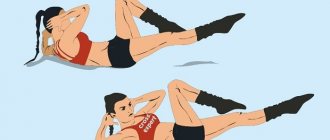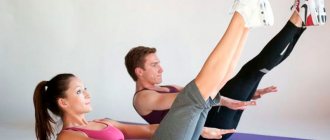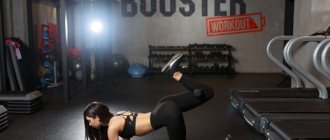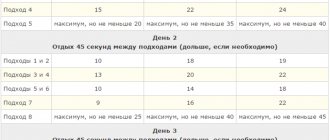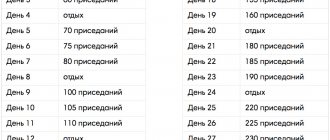Do you want to increase your physical activity, but can't stand gyms? You have every right!
Physical inactivity (lack of movement) is the scourge of modern humanity and an unobvious cause of many diseases. A sedentary lifestyle has a particularly strong effect on the condition of the heart and blood vessels. You don't have to sign up for a marathon or a weight class; you just need to make a few changes to your daily routine. Whichever method you choose, remember the main thing - it is better to change your habits slowly and gradually, but for a long time, than abruptly and quickly, but for a short time.
Walk up the stairs
Running and walking on steps are included in the training program for many sports.
The human brain is programmed to find the shortest and least labor-intensive path to achieving a goal. That is why, on a subconscious level, between the stairs and the elevator, we always choose the latter. Meanwhile, walking up stairs is one of the most effective ways to increase daily physical activity. Let it be a small load: a couple of flights in an office building, a staircase instead of an escalator in a shopping center, or a leisurely descent from your floor on the way to the store. Get into the habit of using the stairs as often as possible.
After a few weeks of regular practice
Daily exercise trains the heart and circulatory system. Vessels are strengthened, blood circulates actively, and the risk of thrombosis is significantly reduced. You don’t feel heaviness in your legs at the end of the day, headaches, or spikes in blood pressure. The level of hemoglobin increases and the number of red blood cells in the blood increases, and the sugar level naturally decreases.
The volume of your lungs increases, you can freely climb several floors of stairs, and walk long distances without shortness of breath. The muscles are strengthened, the figure seems more toned. Posture improves significantly, and slight weight loss is possible.
Motivation for exercise increases; in order not to slow down, it is recommended to diversify your workouts, periodically including new exercises.
Do some cleaning
Cleaning – an additional set of exercises for every day
Sparkling clean windows or a car hood polished to a mirror shine are not only a treat for the eyes, but also have great health benefits. Have you ever thought about how many calories you spend doing housework and what kind of physical exercise you do? Bends, squats, stretching exercises. And often with weights. Therefore, if you love cleaning, then do not deny yourself the pleasure of tidying up while also doing physical exercise.
What happens during training
During half-hour sessions, including a light warm-up, main program and stretching, metabolism accelerates, oxygen consumption increases to 100 liters per minute (compare with 8 liters used at rest). The lungs expand, the blood is saturated with oxygen and delivers it to all important organs, including the heart and brain. Blood viscosity decreases, which prevents thrombosis and damage to small vessels.
External changes are also noticeable. The complexion improves, a healthy glow appears, the eyes shine, the muscles feel pleasant tension. Thanks to the release of endorphins, your mood improves and headaches disappear.
Get up more often
Even when working sedentarily, you need to make time for movement
Sedentary work leads to weakening of muscles, disruption of neuro-reflex connections, nervous system disorders and metabolic disorders. If the situation allows, spend as much time as possible on your feet. Hold meetings with colleagues, conduct telephone conversations with partners, transfer documents to another department without relying on the help of a courier - all this can be done without compromising your business and with health benefits. Try to organize your work schedule so that there is time for even minor physical activity.
Cons of daily training
This applies mainly to activities with above average intensity.
With daily training, the body does not have time to recover. “During rest, the whole body is restored, not only muscles, but also the immune system, the central nervous system,” explains Victoria Tyazhina, personal trainer at the Spirit fitness club on Voikovskaya . “If the first system (the muscle system) recovers the fastest, then the central nervous system recovers slowly and it is very important to give this process enough time so that burnout from training does not occur.”
This can also lead to health problems: for example, with overtraining, immunity deteriorates, and in women the menstrual cycle may be disrupted.
Intense daily workouts harm your muscles. “Muscle fiber takes a long time to recover, in some cases up to two weeks,” says Denis Savchenko, personal trainer at the ArtFitness network of clubs. “If we still don’t feel pain after training, this does not mean that the muscles have already recovered; physiological processes continue.”
Exercising every day increases your risk of injury . If you don't have time to recover between sessions, the quality of your movement will deteriorate, which can ultimately lead to injury.
Should you exercise every day? In general, yes, if you plan your training program correctly.
Help your neighbors
Walking the dog while your neighbor is away – why isn’t altruism beneficial for the body?
Altruism is another reason to move more. Perhaps there is a person living near you who currently needs help. Not necessarily something global like rearranging furniture or painting walls. Going to the store, walking the dog and other household little things can be truly invaluable help for someone. Double benefit - you will help out the person, and you will find another reason for yourself to move more.
It all depends on the scope of the holiday
If we talk about an athlete who took a break for three to five days because of the New Year and did not abuse alcohol and fatty foods, then the break will have absolutely no effect on health and the training process. Another thing is a person who “had a blast” during the New Year holidays, but finished celebrating them by spending the old New Year. It is in this case that the body will react poorly to physical activity, and any workout, be it cardio or strength training, will become real stress.
Remember your childhood
Not a child's play, but a healthy hobby
Surely you remember the sensations you experienced when you first felt balanced in the saddle and rode your first meters on a bicycle. Perhaps it's time to remember your old skills or even learn something completely new? Bicycles, roller skates and even a scooter are no longer “childish fun”, but quite serious hobbies for mature adults. To get started, you can rent sports equipment or borrow it from friends.
How often should you exercise, depending on your goals?
Photo pixabay.com
Some people exercise simply because they enjoy it. But most people still start doing exercises in the hope of getting a certain result: losing weight, getting toned, or neutralizing the negative effects of sedentary work.
Below we provide expert recommendations on how many minutes of exercise per week you should exercise for each specific goal.
If you want to lose weight
The good news is that you don't have to spend half a day at the gym to lose weight, but to see noticeable results, you must also pay attention to your diet (which is to be expected). A recent study published in JAMA Oncology recommends aiming for 300 minutes
moderate physical activity every week.
If you want to tone up
The American College of Sports Medicine gives this advice: if you want to improve your well-being and tone your muscles, then spend at least 150 minutes
per week (or
75 minutes
if you increase the intensity of your classes).
If you want to improve your health
To improve heart and lung function and avoid chronic inflammation, the recommendations are similar to the previous point: 150 minutes of moderate-intensity activity per week (or 75 minutes of vigorous activity).
In addition to strength training and cardio, be sure to include stretching in your schedule, which will help you stay active and protect you from potential injuries.
If you want to sleep better
One study was published on the scientific portal ScienceDirect, which involved more than 2,600 adults. 150 minutes of moderate exercise weekly
per week, had a 65% improvement in overall sleep quality, 68% fewer complaints of leg cramps at night, and 45% fewer complaints of difficulty concentrating when feeling tired, compared to study participants who exercised less than this amount of time.
If you want to reduce the negative effects of a sedentary lifestyle
According to a publication in the Annals of Internal Medicine, a sedentary lifestyle increases the risk of cardiovascular disease, cancer, diabetes and several other diseases.
Therefore, in addition to the universal recipe of 150/75 minutes of activity (depending on the intensity of your training), try to move every hour for at least two minutes (you can set an alarm).
So, the minimum amount of physical activity to stay healthy and sleep well is 150/75 minutes of moderate/intense exercise per week; double this number if you want to lose weight and, in addition to exercising, do not forget to get up from your chair for a couple of minutes if you work in an office all day.
Walk more
Walking is the best remedy against physical inactivity
While walking, all muscles work, and the heart is no exception. The tone of the cardiovascular system helps normalize blood pressure and reduces the risk of many diseases. Obesity, cholesterol plaques, type 2 diabetes - all these diseases are much more common in people suffering from hypertension. Walking is the easiest and, most importantly, effective way to increase your daily physical activity. Try to walk more often, but do not forget that it is much healthier to walk for 15 minutes in the park than to wander along a dusty avenue for an hour.
A few hours after training
Thanks to a good supply of oxygen to the brain, you do not feel tired. Blood pressure normalizes, headaches disappear, memory and reaction speed improve. You don’t feel hungry longer and eat in moderation during meals. The resulting calories are processed faster, reducing the risk of increasing body fat.
At the end of the day, you feel naturally tired and fall asleep much faster. It has been noticed that after moderately intense workouts during the day, sleep is stronger, and the body will need less time to fully recover. You can wake up an hour earlier than usual and feel great. Mild but pleasant muscle pain does not count.
Tips for every day
It takes very little to change your life
- Set your alarm 15-20 minutes earlier to walk one stop.
- Park your car further away. Not having parking close to your office can be beneficial if it means you can spend more time on your feet.
- Walk less, but more often. If your work schedule does not allow you to spend time on long walks, focus on their frequency. Three 10-minute walks are better than none.
- Get up every hour. Try to leave your workplace every one and a half to two hours. A short warm-up or a telephone conversation “on your feet” - all means are good in the fight against physical inactivity.
- Have car-free days. At least once a week, get to work by public transport, or better yet, on foot.
- Find like-minded people. The more supporters of an active lifestyle you attract, the less reason you will have to refuse planned physical activity.
Regular physical activity is not even a brick, but a real granite stone that lies in the foundation of your health. The more you move, the less you think about illnesses.
Is it possible to train every day?
So, let's figure out whether it is possible to train every day.
First, we need to make a few clarifications about this:
- Nature of the load.
- Fitness.
- Training goals.
- Feasibility (effectiveness).
- Load duration.
- Intensity of classes.
Let's start, of course, from the beginning.
Load nature
You need to understand that the loads are completely different.
For example, the nature of the load in the gym (which is what interests us) is completely different than, for example, cardio loads.
Our body constantly maintains an energy balance of energy received (due to food) and consumed.
Energy production occurs in two ways:
- Anaerobic (oxygen-free) catabolism.
- Aerobic (using oxygen) catabolism.
In the gym, energy production in the body occurs due to anaerobic glycolysis (adenosine triphosphate, creatine phosphate, glucose are used), i.e. OXYGEN-FREE TYPE of energy supply.
Due to a load of moderate power with iron, our muscles receive microdamages, the recovery of which requires some time, on average from two to 7 days.
If the loads are constantly the same, we train according to the same program every day, then it is obvious that destruction will prevail over restoration and supercompensation, and, accordingly, there will be no benefit from such training, only harm.
We will lose more protein every day than we accumulate until one of the body's systems fails.
We can improve the situation a little if, for example, we divide our muscle groups into a split and train different groups every day.
For example:
- Monday: Legs + anterior deltoids + abs.
- Tuesday: Chest + triceps + rear deltoids.
- Wednesday: Back + biceps + middle deltoids.
- Thursday: Legs + anterior deltoids + abs.
- Friday: Chest + triceps + rear deltoids.
- Saturday: Back + biceps + middle deltoids.
- Sunday: Press.
And, it seems, everything is fine, but any training athlete will tell you that this load is freaking strong, even for trained athletes training on AAS (androgenic-anabolic steroids).
Because in addition to muscle destruction (which we seem to have smoothed out by splitting muscle groups by day), other systems require restoration: our energy (central nervous system), immune system, nutrient accumulation system, sympathetic nervous system, etc.
With each passing week, such training will accumulate daily under-recovery until, sooner or later, one of the systems gives way.
First, you will become lethargic, contract some illness, and enter a state of deep overtraining.
Sorry if I'm explaining it too confusingly, but I hope you get the idea.
And vice versa, if, for example, the nature of the load is aerobic, i.e. using oxygen, the damage to the body will be minimal, and subsequent recovery will be simpler and faster.
Therefore, if you, for example, really want to train every day, you don’t want to go to the gym, and we are only considering the nature of the load for now, then jogging at a slow pace for 15-40 minutes every day will only boost your well-being for the better .
But the fact is that we are considering this issue not only from the point of view of the nature of the load, so I propose to think further.
Conclusion: Much depends on the nature of the load. It makes a big difference for our body whether we chop wood 6 hours a day or just walk at a brisk pace, because... completely different levels of destruction and different speeds of restoration.
Fitness
A person’s fitness plays a significant role in the issue of daily training.
For a person who is heavier than a spoon and a mouse from a computer during the week, and on weekends drinks himself into unconsciousness to begin with, even 2 times a week training in the gym for the whole body, 3-4 exercises in 2-3 approaches, will be enough.
And for a trained athlete, 5 sets of 6 exercises in training for 2 muscle groups every other day seems encouraging, but not catastrophically difficult.
Do you understand?
Each individual's fitness level greatly influences how their training plan will be structured, so I always ask clients about their level of athletic training and their training experience before we begin working on their body, because... this greatly helps to specialize the program.
For example, an experienced athlete can afford to train one muscle group twice a week or even three times, because... this will allow him to use SPECIALIZATION (to force the lagging muscle group to grow), which a beginner athlete cannot afford, because this will lead him to severe overtraining.
By the way, if you have been training for a long time, read my cool article about training lagging muscles.
Conclusion: The level of fitness greatly influences the number of workouts per week, because... the TOTAL VOLUME OF LOAD depends on this, as well as the body’s ABILITY to digest this load.
Training goals
The goal of a person’s training may differ radically.
If a young guy at 18 wants a bigger bicep, abs and that girl over there, then a man at 40 wants a completely athletic body, also that girl over there and KEEP HEALTHY, at least his knees and lower back.
An athlete who is involved in athletics wants to gain more endurance and does not bother about muscle definition.
A powerlifter takes long breaks between sets and lifts weights that he can only do 1-2 reps with because all that matters to him is POWER for ONE REP.
An 18-year-old girl wants a bulging butt, abs, and toned thighs, and a 30-year-old woman after giving birth wants to quickly regain her figure, get rid of swelling, cellulite and loose abdominal skin.
I'm sure you understand that I'm speaking in a very exaggerated way. That every person of different ages, with different levels of fitness, different approaches to life and interests, of different genders has a GOAL FOR HIS TRAINING ACTIVITY.
With this, I think there are no questions.
Now the next thing is that you and I are mostly interested in the formation of a beautiful body with the help of strength loads, because... this is the most effective and efficient way to a beautiful body.
Our goal is to form a beautiful body.
For this goal to be realized, we do not need to engage in all types of physical activity at once, but rather:
- Power loads.
- Cardio loads.
Now again about goals.
If your goal is, for example, to compete, then it is clear that you do everything for this and this becomes your highest priority.
But even under such conditions, not every athlete will be able to withstand training every day; for the majority, some adjustments will have to be made.
For the vast majority of people, training every day can be implemented under the following conditions:
- The load is short but intense.
- The nature of the load alternates (anaerobic replaces aerobic).
- Presence of “helping” drugs.
- Microperiodization.
I don’t think it’s worth explaining about high-quality nutrition throughout the entire cycle of such training. Nutrition must be strictly observed!
Even if two conditions are met, many people will be able to fit daily exercise into their schedule.
For example, if the load is short but intense, and microperiodization will also be implemented.
Again, if we are talking about competitive bodybuilding, then we are not even talking about “naturalness”; here we use AAS and other drugs that provide pharmacological support to the body, otherwise it will be impossible to “digest” this level of physical activity.
We talked about competitive bodybuilding.
For other people who simply want a beautiful body, the question of PURPOSE immediately arises, which we will talk about later.
But first, a conclusion about the goals of training.
Conclusion: If your main area of activity is related to training (for example, you are a coach, a performing athlete or a fitness blogger), then with the right training program it is possible to train every day, but if you just want a beautiful body, then you can achieve it with much less costs of money, time and effort.
Feasibility (effectiveness)
At this point I would like to share with you some research. But first, a little introduction.
We have already talked above that if your main area of activity is related to training, then it probably makes sense to train every day and then with some amendments; for other people you can do all this with less loss of time and effort.
This is where the question of expediency or, for a simpler understanding, EFFICIENCY arises.
Will muscles grow more efficiently if we train them every day?
Research from 2014 (Wernborn et al. Worsfold PR, Twist C, and Lamb KL.) showed a rational training frequency: 2-3 times per week per muscle group.
Also, a recent (2016) meta-analysis (Schoenfeld BJ, Ogborn D, and Krieger JW. 2016) found a significantly greater increase in muscle mass when training a muscle group 2 times per week compared to 1 and 3 workouts per week.
1 Conclusion: The frequency of training for each muscle group 2 times a week provides greater muscle mass gain.
From the above studies, we draw the first conclusion that it is TWO TIMES A WEEK that will optimally train a muscle group. Here we are not even talking about 7 workouts per week for one muscle group. As we can see from a 2013 meta-analysis, even 3 workouts per week are no longer as effective as 2.
It’s not for nothing that experienced athletes, when catching up with one or another muscle group that is lagging behind in development, sometimes resort to more frequent training. But again, please note that professional bodybuilders resort to the use of pharmacological support, and my recommendations apply to natural athletes.
However, more training requires proper periodization to ensure the proper level of recovery.
Therefore, a scheme for more frequent training for the arms, for example, often does not work, since the arm muscles are already involved in almost all upper body workouts and additional load can only impair proper recovery. We must take this point into account.
This scheme usually works only if the load on the upper body is reduced. But again, we need to look at the development of which muscle group we can sacrifice in order, for example, to add another workout on the arms.
Please note that the frequency of training entails an increase in training volume, so it is necessary to reduce the volume of each individual workout in order not to excessively exceed the weekly training volume.
To explain it very simply, then 2 back workouts with 2 exercises each are much better than 1 back workout with 4 exercises.
I think this is clear.
Okay, why then shouldn’t you train more often than 2 times a week?
Very simple.
Because after strength training, the muscle group restores the normal state of protein synthesis on average up to 48-72 hours, therefore, in order to avoid disruption of anabolic processes (growth), at least the same 48-72 hours of rest are required.
But this scheme is NOT SUITABLE FOR BEGINNERS! Why?
One study (Dankel et al. 2022) suggests that frequent training is less optimal for untrained individuals because subsequent resistance training will interfere with and promote the breakdown of muscle contractile proteins.
This hypothesis requires further research, because She is quite young, but at the moment all practical developments speak in her favor.
The ideal scheme for a beginner would be to train 2-3 times a week for the whole body (fulbadi), thus the likelihood of overtraining will be minimal.
With all the everyday activity, active work and other everyday activities, at the very beginning you can completely discourage yourself from training if you give it an excessive load, which, among other things, will not give a better result, but will reduce it.
2 Conclusion: For beginners, daily training will not give the best effect for muscle growth, but will only provide excess load for recovery.
By the way, if you want, you can choose your first individual training session using my system absolutely free by simply clicking on one of the buttons below.
Duration of load
A lot has also been said about the duration of the load.
I’ve read many places that the duration of a workout should not be more than 45 minutes, but few people say that no cortisol begins to mercilessly devour our muscles after this time, and the ability to digest the load is different for all people.
Some people won’t be very exhausted even after 1.5 hours of training, while others will breathe like the last time even after half an hour.
I even wrote a cool article on the topic of how long you can train. Read it. I'm sure you'll find a lot of interesting things there.
Working out 15 minutes in the gym on one muscle group every day is not the same as pushing yourself every day for 1.5 hours in the gym, training each muscle 3 times a week. The volume of load is different and the time the muscles are under load is different.
Be sure to take this point into account.
Conclusion: The duration of the load greatly influences your progress and ability to recover, because... training volume increases. If we talk only about duration, then a little, but intensely, is often better than long and sluggish.
Intensity of classes
You can greatly increase your training volume by increasing the intensity of your training.
The dependence here is quite direct.
We can increase the intensity of our training through three main things:
- Reduce rest between sets.
- Reduce rest between exercises.
- “Super moves” (dropsets, supersets, cheating, etc.).
Roughly speaking, we can rest less between exercises, due to this we will make the workout faster, and accordingly, the intensity of the session has increased. We have only reduced the rest time, but the progression of loads has already appeared.
If we are talking about daily training, then few people will be able to train 7 days a week at high intensity, and a little higher we found out that this is completely unnecessary.
But it is quite possible to alternate high-intensity training with moderate and low-intensity training.
For example, I train 3-4 times a week in the gym, and at home 2-3 times a week on free days I do abdominal training. Does this mean I exercise every day? Probably, in fact, yes, I do physical exercise every day. You can say so conditionally.
But the intensity is completely different and so is the duration. Working out in the gym for 1.5 hours at high intensity is one thing, but doing abs at home in 15 minutes on the floor in front of the computer is completely different.
By the way, here is one of my latest press photos:
Daytime workouts
Daytime training is more suitable for schoolchildren or students, as well as those whose work schedule allows them to devote 1-2 hours to training in the afternoon.
pros
- Body temperature is slightly higher than in the morning. It will be easier and more comfortable for you to start exercising.
- Glycogen reserves in muscles and blood sugar levels are at a good level.
- Improves blood flow to the brain. After training, you will be able to work even more productively.
- Reduces stress levels after work and study. You can throw out all the negative energy in the room.
- At this time, endurance increases. This is what is important for weight training.
- Research shows that this is when our lungs are at their most efficient.
Minuses
- Distractions that may prevent you from starting your workout at the scheduled time.
- If you train during your lunch break, the downside is that you are limited in time and the training may end up being unfinished.
To summarize, it should be said that at this time the most effective exercises will be strength exercises, stretching, crossfit and other exercises that require endurance and strength. Before such training, you should definitely take care of your food intake.
TRAINING PROGRAM
Monday
We train the top. Complete beginners work with light weights, doing 3 sets of 15 repetitions at a time. More experienced ones can work with medium weights, performing exercises in 2 sets, 8-10 repetitions at a time. We do the following exercises:
- We press dumbbells while lying down.
- Butterfly simulator (all exercises on it).
- Press dumbbells in French (lying)
- Extend the triceps on the upper block.
- We press in the military style while standing.
- We spread our arms with dumbbells while standing.
- On the Scott bench we lift the EZ-bar (biceps exercise).
- We sit on a chair or bench and finish off the biceps with dumbbells.
- Pull the upper block with a wide grip.
- We do bent over dumbbell rows.
- Shrugs with dumbbells.
Tuesday
We train the bottom and abs. The weights, number of sets and repetitions are the same as on Monday based on your level of training. We will work with these numbers until the end of the week.
All exercises are performed on simulators, except for the eighth point. Exercises:
- Leg press.
- Straighten your legs.
- We bend our legs while sitting.
- We bend our legs while lying down.
- We rise on our toes while standing.
- We rise on our toes while sitting.
- We twist the torso on the press bench.
- Twisting the body while lying on the floor.
Wednesday
Day off.
Thursday
The top works. If desired, all exercises from Monday are repeated, the following are additionally added:
- We pull ourselves up on the crossbar.
- We do deadlifts on the lower block.
- We do vertical pull-downs to the chest of the lower block.
- We work the biceps with the EZ bar while standing.
- Hammer grip. We lift dumbbells (working the biceps).
- We do dumbbell presses on a bench (lying) with a positive incline.
- Bringing hands together (in crossover).
- Barbell press (seated).
- Exercise with rope handle (triceps extension, upper pulley).
Friday
The bottom works. The exercises are repeated from Tuesday, the following are added:
- Hack squat with narrow feet.
- Standing leg curl (simulator).





